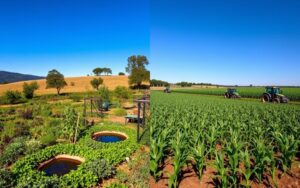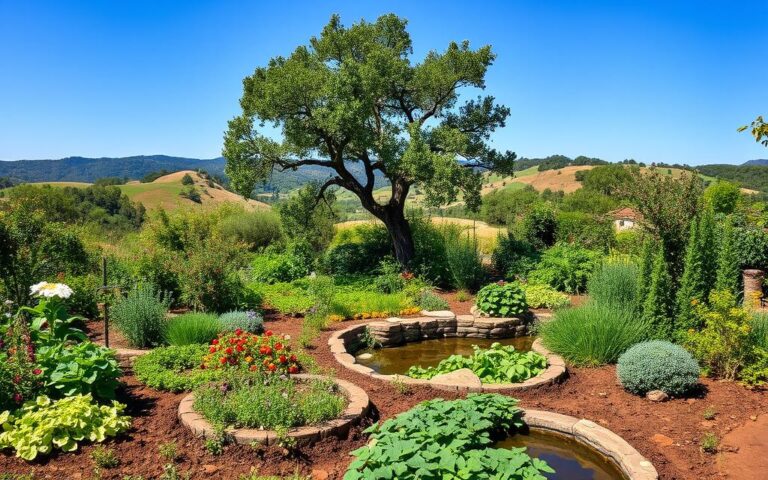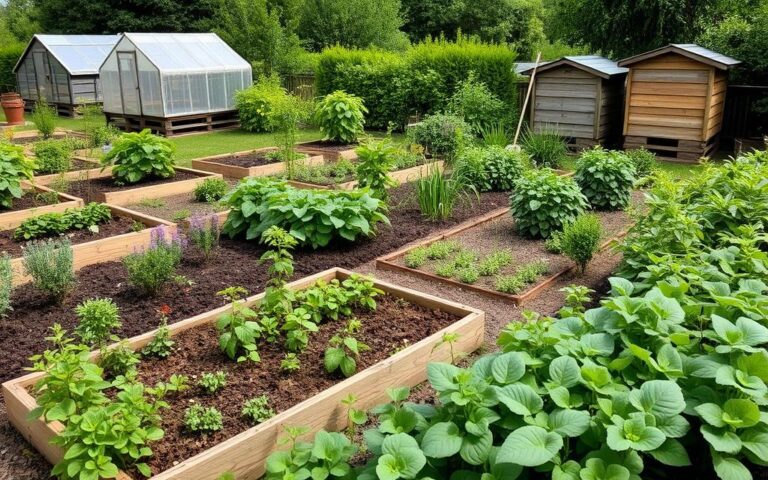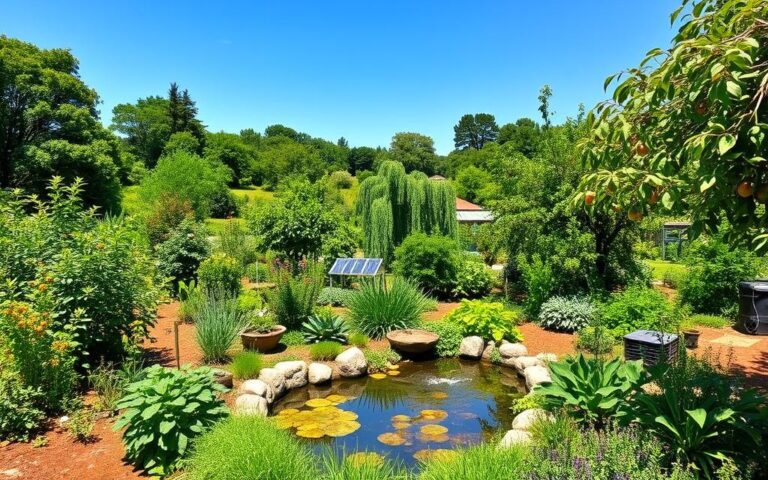Did you know that about 40% of the world’s land is used for farming? This has a big impact on our environment. We’re looking at two ways to farm: permaculture and traditional farming. Permaculture tries to copy nature, using methods that are good for the planet. Traditional farming often uses one crop at a time and chemicals.
It’s important to know about these farming ways. They affect our environment and how we get food. Let’s explore these different farming methods and how they impact our planet.

Introduction: Understanding the Differences
Learning about the differences in farming practices helps us see how they affect the environment. Sustainable agriculture uses many farming methods to reduce harm to nature. It aims to keep biodiversity and save resources. Permaculture principles are a key part of this, blending land, people, and nature together.
On the other hand, traditional farming is all about growing a lot of food quickly. It uses lots of chemicals and grows the same crops over and over. This can hurt the soil and reduce the variety of life.
Looking into permaculture and traditional farming shows us the wide range of ways to farm. It helps us understand their effects on the planet.
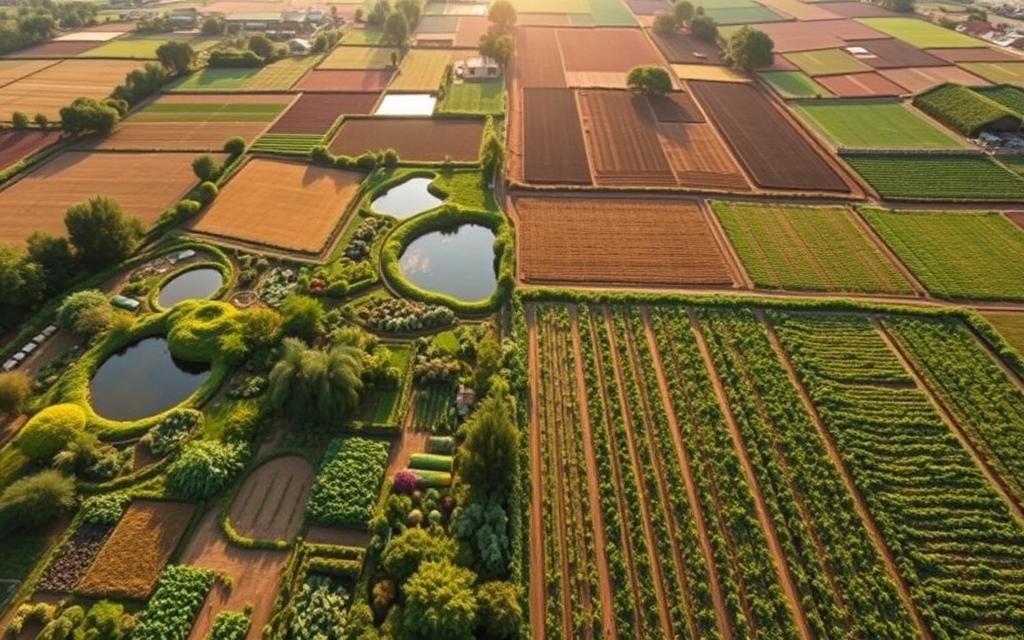
Water Management: Conservation vs. Irrigation Waste
Effective water management is key to making farming more sustainable. Different farming systems use different ways to save water. This affects their efficiency and success. Permaculture and traditional farming show two different views on using water wisely.
Permaculture Approaches to Water Conservation
Permaculture uses new methods to save water. It focuses on:
- Rainwater harvesting: This captures rainwater for later use, cutting down on the need for outside water.
- Swales: These are shallow, curved ditches that help water reach plants and prevent soil erosion.
- Mulching: Using organic mulch keeps the soil moist and makes irrigation systems work better.
Permaculture aims to use water efficiently by working with nature. This makes it a better choice than traditional farming.
Traditional Farming Water Management Practices
Traditional farming often uses a lot of water and wastes it. It includes:
- Flood irrigation: This method floods fields but can cause a lot of runoff and evaporation.
- Fixed sprinkler systems: These can water unevenly, wasting water.
- Excessive groundwater extraction: Using too much from aquifers can harm the environment.
These methods can hurt water conservation efforts. Looking at both shows us how to make farming more sustainable.
| Aspect | Permaculture | Traditional Farming |
|---|---|---|
| Water Conservation Techniques | Rainwater harvesting, swales, mulching | Flood irrigation, fixed sprinkler systems |
| Irrigation Efficiency | High | Low to Moderate |
| Impact on Water Resources | Sustainable | Often Depleting |
Soil Health: Natural Regeneration vs. Chemical Dependency
Soil health is key for sustainable farming. Permaculture and traditional farming show the importance of soil care. Permaculture boosts soil health naturally, while traditional farming uses chemicals that can harm it.
The Role of Soil Microorganisms in Permaculture
In permaculture, we focus on soil microorganisms. These tiny helpers are crucial for nutrient cycling and soil structure. They break down organic matter, making nutrients available to plants.
This natural process makes ecosystems more resilient and improves soil health. Healthy soil supports plant growth without synthetic additives, ensuring long-term sustainability.
Impacts of Chemical Fertilizers in Traditional Farming
Traditional farming often uses chemical fertilizers to increase crop yields. While it works in the short term, it can harm soil health over time. Chemicals can reduce organic matter and disrupt soil microbes.
This reliance on chemicals threatens biodiversity and soil fertility. It’s a concern for the long-term health of our soil.
Biodiversity: Monoculture vs. Polyculture
Biodiversity is key to healthy and stable farms. Monoculture farming grows just one crop over big areas. But, polyculture farming grows many crops together. This mix makes farms stronger against pests and diseases, needing fewer chemicals.
Monoculture farming can upset nature. Growing the same crop over and over makes pests worse. Without variety, natural controls are lost. But, polyculture farming brings more life to farms. It makes soil better, improves nutrient flow, and boosts biodiversity.
| Aspect | Monoculture Agriculture | Polyculture Systems |
|---|---|---|
| Crop Diversity | Low | High |
| Pest Vulnerability | High | Low |
| Soil Health | Degraded | Improved |
| Ecological Balance | Imbalanced | Balanced |
| Dependence on Chemicals | High | Low |
Polyculture farming boosts biodiversity and supports sustainable farming. It makes farms richer in life and helps farmers and the environment.
Energy Use and Carbon Footprint
The way we use energy in farming affects both how efficient we are and our carbon footprint. Permaculture takes a different path than traditional farming. It focuses on using energy in a way that’s better for the planet.
Energy Requirements in Permaculture
Permaculture uses nature’s power and local resources. It doesn’t rely much on outside energy. This makes farming more efficient and cuts down on energy use.
Less machinery is needed because of this approach. It’s all about working with nature, not against it.
- Utilizing solar energy for tasks such as drying and heating.
- Implementing integrated systems that reduce transportation needs.
- Using organic practices that eliminate reliance on synthetic fertilizers.
Carbon Emissions from Traditional Farming Practices
Traditional farming, on the other hand, uses a lot of fossil fuels. This leads to more carbon emissions. The use of machinery, transport, and synthetic inputs all add to the problem.
- Heavy machinery usage for plowing, planting, and harvesting.
- Transportation of fertilizers and pesticides from far-off locations.
- High energy consumption associated with irrigation systems.
Comparing permaculture to traditional farming shows why we need to be more efficient. Lowering our carbon footprint helps the environment and makes farming stronger.
| Aspect | Permaculture | Traditional Farming |
|---|---|---|
| Energy Sources | Natural, local | Fossil fuels |
| Machinery Use | Minimal | Extensive |
| Synthetic Inputs | None | High |
| Carbon Emissions | Low | High |
Long-Term Sustainability and Economic Viability
Looking at how long agricultural practices last shows big differences. Permaculture and traditional farming have different ways of working. Permaculture uses a whole system approach, boosting biodiversity and cutting down on chemicals. This makes it more resilient over time, helping the environment.
Traditional farming, on the other hand, often needs outside help. This can lead to quick gains but harm the soil and nature.
How much money a practice makes is also key. Permaculture offers many ways to earn money, like growing different crops and using agroforestry. It also saves money because it uses less. Traditional farming faces ups and downs in the market and high costs for chemicals and pesticides. This can hurt its profits.
Studying the economics of these methods helps us see their impact on food systems. It shows the environmental and economic gains of choosing permaculture.
| Agricultural Practice | Long-Term Sustainability | Economic Viability |
|---|---|---|
| Permaculture | High – diverse and resilient ecosystems | Strong – multiple income sources, lower costs |
| Traditional Farming | Moderate – reliant on chemical inputs | Challenging – exposure to market fluctuations |
Examples of Successful Permaculture Farms
Looking at successful permaculture farms gives us a peek into new ways of farming. These farms show us how to care for the environment in a way that traditional farming doesn’t. By studying case studies, we see how permaculture can be good for the planet and our wallets.
Case Study: A Prominent Permaculture Farm
The Green City Farms in Maryland is a great example. They use vertical gardening and aquaponics to grow lots of food without chemicals. This method boosts biodiversity, fights pests naturally, and makes the soil healthier. It proves that permaculture can be profitable, providing fresh food all year for local markets.
Comparative Analysis with Traditional Farms
It’s important to compare permaculture with traditional farming. The table below shows how they differ, focusing on how green they are.
| Metric | Successful Permaculture Farms | Traditional Farms |
|---|---|---|
| Soil Health | Rich in organic matter, supports diverse microorganisms | Dependent on chemical fertilizers, often depleted |
| Water Usage | Conserves water through rainwater harvesting and drip irrigation | Higher waste through standard irrigation methods |
| Biodiversity | Utilizes polyculture practices, diverse crops | Predominantly monoculture leading to vulnerability |
| Economic Viability | Generates income through local markets, community support | Often reliant on subsidies and market fluctuations |
Permaculture vs Traditional Farming: Which Is More Sustainable?
The sustainability comparison between permaculture and traditional farming shows big differences. Permaculture works with nature, aiming for permaculture sustainability with diverse crops and regenerative practices. This approach boosts biodiversity and soil health, making ecosystems stronger.
Traditional farming impacts include using chemical fertilizers and growing just one crop. These methods harm soil, lower biodiversity, and make farms more vulnerable to pests and diseases. Permaculture, on the other hand, focuses on natural regeneration and soil microorganisms for nutrient cycling.
Permaculture needs less fossil fuel because it uses local resources and renewable energy. Traditional farming uses a lot of machinery and transports goods far, leading to more carbon emissions.
Permaculture’s sustainable practices show it cares for the environment, unlike conventional agriculture. Below is a detailed comparison of these key differences.
| Aspect | Permaculture | Traditional Farming |
|---|---|---|
| Resource Management | Regenerative, using natural ecosystems | Dependent on chemical inputs and monoculture |
| Biodiversity | High biodiversity with diverse plant species | Low biodiversity, often single-crop systems |
| Soil Health | Improves over time through natural processes | Can degrade over time with chemical usage |
| Energy Use | Lower due to local resources | Higher due to machinery and transportation |
| Long-Term Viability | Potential for sustainable, enduring systems | Often vulnerable to market and environmental changes |
Sustainable Practices in Agriculture Today
Sustainable farming methods are becoming more popular. They include regenerative agriculture and agroecology. These methods aim to make ecosystems healthier and improve food production. They also tackle environmental problems.
By using regenerative practices, farmers can improve soil health. They also boost biodiversity and help create a strong food system.
Regenerative Practices and Their Importance
Regenerative agriculture focuses on keeping ecosystems healthy. It helps to lock carbon in the soil, reduce erosion, and keep water in the soil. Techniques like cover cropping and reduced tillage are key.
These methods help plants, soil, and wildlife work together. They create a balanced ecosystem.
Agroecology and Sustainable Food Production
Agroecology mixes science with traditional farming. It aims to create sustainable food systems. It uses local resources and promotes biodiversity.
By using different crops together, farmers can cut down on synthetic inputs. This improves yields and food security. Agroecology and permaculture share similar goals for sustainable farming.
| Practices | Regenerative Agriculture | Agroecology |
|---|---|---|
| Main Focus | Soil health improvement | Enhancing local biodiversity |
| Key Techniques | Cover cropping, reduced tillage | Multi-cropping, agroforestry |
| Environmental Benefits | Carbon sequestration, erosion control | Resource conservation, habitat enhancement |
| Economic Impact | Increased yields, lower input costs | Improved food sovereignty, community empowerment |
Conclusion: Why Permaculture Is the Future of Agriculture
Permaculture is a game-changer in agriculture. It focuses on balanced ecosystems and natural processes. This approach boosts crop yields and soil health, making food production sustainable.
Permaculture tackles big issues like climate change and food insecurity. It shows that its benefits go beyond the farm. This makes it a key player in the future of agriculture.
Permaculture helps create resilient farms that can handle environmental changes. It uses nature’s ways, like companion planting and agroforestry. These methods improve soil and reduce chemical use, making farming more sustainable.
Now, more than ever, we need sustainable food production. Permaculture’s principles can lead us to a healthier world. By working with nature and promoting biodiversity, we can make agriculture productive and green. Choosing permaculture is crucial for a thriving planet.
FAQ
What is the primary difference between permaculture and traditional farming?
Permaculture aims to create sustainable farms that work like nature. It promotes many plants and balances the ecosystem. Traditional farming often uses one crop and chemicals, harming the environment.
How does permaculture contribute to sustainable agriculture?
Permaculture uses methods like saving soil and growing food in a way that’s good for the planet. It boosts biodiversity and soil health, leading to sustainable food.
What are some water management techniques used in permaculture?
Permaculture collects rainwater and makes swales to save water. This helps reduce waste and conserve water.
How does soil health differ between permaculture and traditional farming?
Permaculture improves soil naturally and supports tiny life in the soil. Traditional farming uses chemicals that can harm the soil over time.
Why is biodiversity important in agriculture?
Biodiversity helps farms fight pests and diseases better. Permaculture uses many plants, unlike traditional farming’s single crops.
What is the impact of energy use in permaculture vs. traditional farming?
Permaculture needs less outside energy, using nature’s ways. Traditional farming uses a lot of fossil fuels, leading to more carbon emissions.
How does the economic viability of permaculture compare to traditional farming?
Permaculture can be more profitable over time with many income sources and lower costs. Traditional farming may start strong but faces market and chemical input challenges.
Can you provide examples of successful permaculture farms?
Many permaculture farms around the world show how it works. They use clever garden designs and trees to grow food, proving it’s good for the planet and wallet.
What role does regenerative agriculture play in sustainable practices?
Regenerative agriculture focuses on making land better, increasing life, and ensuring food for the future. It’s very similar to permaculture’s goals.

